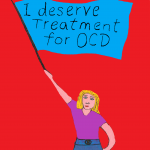CBT: What is it? In simple terms
November 14th 2014
This blog post is all about the most common way in which OCD is fought: the practice of CBT (Cognitive Behavioural Therapy).By Matt, 16 years old, from England
When you visit a place that practices CBT, such as your local CAMHS (Child and Adolescent Mental Health Service) or other clinic, they can use some quite complex vocabulary that at first I didn’t even understand.
Now, after asking many times and after many visits over the course of seven years overall, I’m here to give you the information in an easy to understand way, which hopefully you can use to better understand the treatment of OCD. Initially, your therapist may give you an explanation similar to this:
“By exploring patterns of thinking that lead to self-destructive actions and the beliefs that direct these thoughts, people with mental illness can modify their patterns of thinking to improve coping. CBT is a type of psychotherapy that is different from traditional psychodynamic psychotherapy in that the therapist and the patient will actively work together to help the patient recover from their mental illness. People who seek CBT can expect their therapist to be problem-focused, and goal-directed in addressing the challenging symptoms of mental illnesses. Because CBT is an active intervention, one can also expect to do homework or practice outside of sessions.” (National Alliance on Mental Illness)
I’m 16 and when I first went I had no clue what he was saying, I just nodded and said yes a lot. After a while I asked again and asked to have it simplified, after which he offered another similar explanation. I was disappointed and began to research it. Eventually I came to this conclusion:
“Depending on your problem whether it be with germs, or having items in a particular order, or something completely different, therapists can help you to think about what’s wrong and what you imagine is going to happen, until you feel better and are able to cope with this. Other types of CBT can include such forms as exposing you to germs on a door handle and not letting you wash your hands as a ritual.”
In conclusion, overall all CBT is helping you get over fears by facing them, which is easier said than done. It’s nothing to be afraid of though as it has a high success rate and can be a really useful tool, whatever type of OCD you have.







